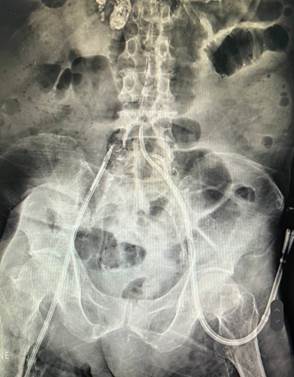Welcome to the vascular access clinic. If you are reading this, you or a loved one may require hemodialysis due to renal failure. This webpage will provide information about dialysis tube so called temporary catheters, specifically the semi-permanent catheter (Perm Catheter-PermCath) and temporary catheter (double lumen catheter), which facilitate this treatment.
What are Temporary Catheters?
Temporary catheters, such as the PermCath and double lumen catheter, are specialized tubes inserted, often into large veins in the neck or chest, to provide access for hemodialysis.

The left image shows a patient with a temporary (hard) dialysis catheter in the right side of the neck.

The right image shows a patient with a semi-permanent (soft) dialysis catheter inserted in the right side of the chest.
- Why Do You Need a Temporary Catheter?
In certain situations, immediate vascular access is needed for dialysis, especially if:
An arteriovenous fistula (AVF) or graft (AVG) hasn’t matured or is not functional.
There’s an urgent need for dialysis due to rapidly worsening kidney function, so such catheters are needed.
- Features of Different Catheters:
PermCath: Designed for longer-term use, this catheter can stay in place for weeks to months. It’s often used when more permanent access (like an AVF) isn’t immediately available.
Double Lumen Catheter: Typically used for short-term access, it has two channels—one to draw blood from the body into the dialysis machine and another to return the cleaned blood to the body.

This picture shows the Permcath dialysis catheter in the upper panel and the double lumen catheter in the lower panel

The image shows a patient undergoing dialysis through a temporary catheter
- The Insertion Procedure:
Preparation: You might be asked to fast for a few hours before the procedure. Ensure you follow any specific instructions provided by our healthcare team.
During the Procedure: Under local anesthesia and sedation, the catheter is inserted. The process usually lasts less than an hour.
Post-Procedure: You’ll be observed for a short period before being discharged.
- Risks and Complications:
While catheter placement is generally safe, there are potential risks:
Immediate: Bleeding, infection, air entering the chest cavity.
Later on: Catheter malfunction, infections, blood clots.
Always contact the staff of our clinic with any concerns.

Vein stenosis in the chest, which often results from previous dialysis catheter placements, requires great caution during medical procedures. If not performed carefully, it can lead to vascular tearing and significant bleeding. Our clinic is equipped with advanced tools for such procedures, including ultrasound imaging and digital fluoroscopy, ensuring the highest level of safety for patients.
- After the Procedure:
Recovery: Minor discomfort is expected, which usually subsides in a few days.
Monitoring: Ensure the catheter site remains clean and dry. Report any signs of infection or malfunction.
Dialysis Use: The catheter can usually be used for dialysis shortly after placement.

The image shows the placement of a semi-permanent catheter in the right side of the neck.

The image shows a patient with a double lumen catheter on the left side of the image. Later, a Permcath was inserted in the right side of the image
- Caring for Your Catheter:
Cleanliness: Keep the exit site clean and dry.
Avoid Pressure: Do not pull or put undue pressure on the catheter.
Medical Precautions: Use the catheter only for dialysis. Avoid submerging it in water, like during bathing.
- Advantages of Temporary Catheters:
Immediate Access: Provides quick access for urgent dialysis needs.
Flexibility: Useful when other access points are not available or suitable.
- Frequently Asked Questions:
- Will it hurt?
Some discomfort might be felt during insertion, but this is minimized with anesthesia.
– How long will it stay in?
This depends on the type of catheter and individual circumstances. Your doctor will provide guidance.
We understand that starting dialysis is a significant transition. Our team is here to guide and support you every step of the way. Always reach out with any questions or concerns.